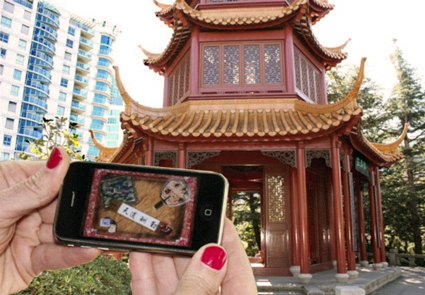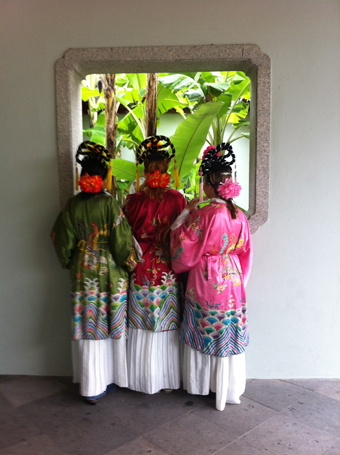apps, dim sum & astronauts' wives
kirsten krauth: annette shun wah's china heart

China Heart
photo courtesy d/Lux/MediaArts
China Heart
THE CHINESE LUNAR NEW YEAR BEGAN FEBRUARY 3. IT’S THE YEAR OF THE RABBIT. TO CELEBRATE WE PARK AND STROLL SLOWLY (LIKE A PAIR OF DUCKS) TO THE POWERHOUSE MUSEUM; IN THE LIGHT RAIN, HEAVILY PREGNANT, I WADDLE. WE HOPE FOR A HAPPY MARRIAGE, CLEAR DIRECTIONS VIA GOOGLEMAPS, A YEAR OF HEALTH AND WEALTH. AT THE POWERHOUSE WE DOWNLOAD OUR IPHONE APP FOR CHINA HEART.
There’s a map with various spots highlighted. Videos to watch like mini soap operas. Special objects from the museum are displayed in a glass case. As strains of the museum’s AbbaWorld karaoke filter in, we look at papercuts, toggles for men’s belts used to hold small bags of tobacco, a fan with low-flying ducks.
We begin the journey perched on a red leather seat. We’re guests at an engagement party—a mother-in-law gives a speech in English at first, turning to her native tongue when distressed. Her daughter, Lian, understands but in anger won’t translate; her son-in-law, a ‘good boy,’ is oblivious to her pain. A mysterious parcel arrives with a note that needs translation. After a fight with her mother (about a father who has died, who was never really around before), Lian suggests Chinatown, to find out more about the note (and her ancestors).
We head off looking for clues. The Southern Gates of Chinatown—no, not the golden arches of Maccas nearby—are the first stopping point. The clues are cryptic but the answers easy to find. As we head through Chinatown we are distracted again and again to follow our own hearts: late yum cha customers spill onto sidewalks with banquets piled high (we are told that “for romantics,” dim sum can mean “to touch the heart”); a dragon-twisted queue waits patiently for the Emperor’s Cream Puffs, a “supreme nutritious snack”—what are they? I want one.
Shops sell masks, cheap dragon puppets on strings and glittering lipstick cases while a dragon lies beneath the city linking the Chinese districts. We watch the narrative unfold in noisy streets, struggling to hear through the iPhone speakers. At Albion Place, women recount their experience of debutante dances and Dragon Balls at the Trocadero—we’re invited to imagine a building that no longer stands— remembering how the chutes above the roof would open out to rain streaming down on dancers doing the can-can.
We wonder at the lack of interactivity. It seems we are following a formula, being told by our iPhone what to do. Where’s the chance to talk back, to take photos, to interpret what we find, to tell our own stories? Perhaps as we proceed…
Men flip roti and make satay in the windows as we snake back through the streets to Belmore Park, the original site for the Chinese market gardens. The narrative turns from fiction to documentary as we weave into the Capitol Theatre, the eventual site for the markets (the facade decorated with fruit and flowers) and meet an English woman who, posed in front of historical photos, tells of her desertion by a Chinese man who returns to his country. Her story echoes the more recent accounts of the “astronauts’ wives” (Lian’s mother is one) who, through the 1990s, recount the years of bringing up their children in Sydney while their husbands ‘go into orbit’ in Hong Kong to work, leaving their families for years; a sad contrast with the symbolism of the two ducks on the fan, swimming together and mating for life. The juxtaposition of happy marriage and absent husband/father is played out throughout China Heart and gives the central video narrative its edge of melancholy as a couple prepares for their wedding. But walking through the city reminds us of the times we have loved, the food we have discovered, how the streets have changed, and we sit down and have a Valentine’s Day dinner, ordering pork buns and stuffed eggplant. The couple next to us order Peking duck, the waiter tenderly placing the skin onto pancakes.

China Heart
photo Damon Girbon
China Heart
Sitting in the Chinese Gardens of Friendship eating yum cha with a pot of tea, we watch Lian and her mother sitting eating yum cha with pots of tea. Then, looking out over the lotus pond, we watch Lian and her beau contemplate the same expanse of water (her father reappears on the surface offering closure). The nature of mobile technology offers the chance to experience the narrative in the exact location where the characters were filmed, and a kind of frisson emerges in the experience, the retelling via iPhone means making connections in real space. A group of teenage girls in magnificent Chinese dress wobble as they balance delicately on stone bridges over the water. At first we think they are the promised Chinese opera performers but as they edge closer, and we take their photo, they point to a sign that directs visitors to where they can play dress-ups and try on traditional outfits.
China Heart seems a starting point for a technology just beginning to emerge—a tourist guide-meets-ficto-historical narrative—that doesn’t quite use the possibilities of the app to full effect. It works more like a school excursion (join the dots; great for children) rather than an integrated media work. It’s a disjointed experience on your feet, but it helps if you revisit the journey online (all the videos and links are available to explore using a regular web browser). The possibilities—for linking histories, documentary, narrative fiction, interaction with users, maps and locations, museum resources, web links—are just starting to open up.
China Heart, writer, director, producer Annette Shun Wah, producer Josephine Emery, presented by d/Lux/MediaArts, 4A Centre for Contemporary Asian Art, the Powerhouse Museum and the Project Factory; Jan 30-Feb 13
You can still do the walking tour by downloading the free app or take the journey online via the China Heart website, www.chinaheart.org.au
This article was first published online April 5, 2011
RealTime issue #102 April-May 2011 pg. web






